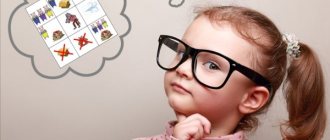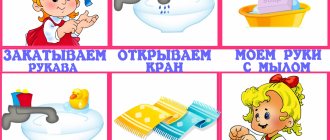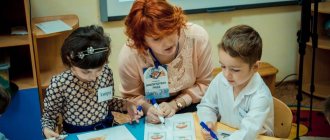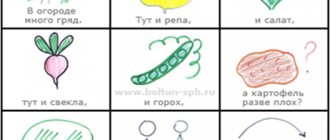An important condition for the development of preschool children is coherent speech. The child’s ability to explore the world around him depends on the level of its formation. But there are often serious gaps in the speech of preschoolers. These include: a small vocabulary, errors in the construction of sentences, inexpressive reading of poetry, etc., which may later affect learning at school. The causes of such problems may be a lack of verbal communication between children and parents, adults’ lack of awareness about the correct development of a child’s coherent speech, and the meager vocabulary of the parents themselves.
If adults have expressive speech, then the child speaks well and does not experience difficulties in communication. To eliminate these problems, you can use modern technologies.
What is a mnemonic table
Mnemonic tables are an effective technology for forming coherent speech.
Together with classical methods of speech development, mnemonics are actively used in preschool practice.
Mnemonics are methods and techniques that affect the memorization, storage and reproduction of information. Such a system is based on the creation of certain associations-images that promote the development of memory and coherent speech, manifested in the statements of preschool children in the form of description, narration and reasoning.
For children, this is a complex speech activity, so the methods of work should be accessible and understandable, and arouse their interest. To do this, adults themselves must have a good command of mnemonics in order to use it in the development of coherent speech in preschoolers.
Taking into account the psychological characteristics of children: visual-figurative thinking, involuntary processes of memory and attention, creative imagination, teachers use mnemonic techniques for the correct construction of speech in preschool children. An important place among them is occupied by mnemonic tables, or diagrams with code information. Since in preschool age visual-figurative thinking remains the dominant one, therefore the perception and processing of information will be best built on the basis of visual images.
The use of mnemonic tables is available not only to teachers, but also to parents. Everyone knows that preschool children love to draw, and in their drawings they depict all the objects of the surrounding world, natural phenomena, people who are next to them, the plots of their favorite fairy tales, etc. On this children's desire for creativity, work must be done to teach children mnemonic tables , not forgetting that this activity presupposes the presence of a certain level of thinking and creative skills of the child.
It is best to start with color tables, since images in the minds of children are built on specific properties of objects: if the sky is necessarily blue, snow is white, orange is orange. For older preschoolers, who are already developing logical thinking, it is better to switch to a black and white picture so that the color does not distract the child from the schematic image. This is how children learn the concept of “encoding a word.” Parents should not be scared by this; everyone in life encounters information coding: road signs, school puzzles, algorithms, etc.
The use of mnemonics in the development of children's speech
Author: Yuryeva Anna Mikhailovna
Preschool education is the first stage in the education system, therefore the main task of teachers working with preschoolers is to develop interest in the learning process and its motivation, development and correction of speech. Today it is absolutely possible to identify the emerging contradictions between the normative content of education common to all pupils and the individual capabilities of children. Children of senior preschool age with various speech disorders experience significant difficulties in mastering both the kindergarten curriculum and the curriculum in a comprehensive school. Learning difficulties are especially common for children with special needs. It is no secret that such children have the following problems: a poor vocabulary, inability to coordinate words in a sentence, and impaired sound pronunciation. Most children have impaired attention and imperfect logical thinking. Therefore, speech therapy in eliminating general speech underdevelopment is a very difficult matter. It is necessary to teach children to express their thoughts coherently, consistently, and grammatically correctly, and to talk about various events from the surrounding life.
Considering that at this time children are oversaturated with information, it is necessary that the learning process be interesting, entertaining, and developmental for them.
Let's consider the factors that facilitate the process of developing coherent speech.
One of these factors, according to S. L. Rubinshtein, A. M. Leushina, L. V. Elkonin and others, is visibility.
Examining objects and paintings helps children name objects, their characteristic features, and actions performed with them.
As a second auxiliary factor, we will highlight the creation of a plan of utterance,
the significance of which was repeatedly pointed out by the famous psychologist L. S. Vygotsky. He noted the importance of sequential placement of all specific elements of an utterance in a preliminary scheme.
So how can you shape a child’s speech, recall it with a large palette of words, beautiful phrases, euphonious phrases? How to help a child feel the rhythm of speech, the melody of words, and experience the content of the speech he hears? How to promote the development of a child’s emotional and sensory sphere and help him learn communicative speech?
I found all the answers to these questions in the mnemonic technique.
Mnemonics in preschool pedagogy are called differently: Valentina Konstantinovna Vorobyova calls this technique sensory-graphic schemes
, Tkachenko Tatyana Aleksandrovna -
with subject-schematic models
, Glukhov V.P. -
with blocks-squares
, Bolsheva T.V. -
with collage
, Efimenkova L.N. -
with a diagram for composing a story.
Mnemonics is a system of methods and techniques that ensure children’s successful acquisition of knowledge about the characteristics of natural objects, the world around them, effective memorization of the structure of a story, preservation and reproduction of information, and of course the development of speech.
The use of mnemonics for preschoolers is currently becoming more relevant. The goal of training is the development of memory, thinking, imagination, attention, namely mental processes, because they are closely related to the full development of speech. The basis of training is the development of creative cognition.
Therefore, the relevance of using visual modeling in working with preschoolers is that:
· firstly, a preschool child is very flexible and easy to teach, but children with ODD are characterized by rapid fatigue and loss of interest in activities. Using visual modeling creates interest and helps solve this problem;
· secondly, the use of symbolic analogy facilitates and speeds up the process of memorizing and assimilating material, and forms techniques for working with memory. After all, one of the rules for strengthening memory says: “When you learn, write down, draw diagrams, diagrams, draw graphs”;
· thirdly, using a graphic analogy, we teach children to see the main thing and systematize the knowledge they have acquired.
Like any work, mnemonics is built from simple to complex. It is necessary to start working with the simplest mnemonic squares, sequentially move on to mnemonic tracks, and later to mnemonic tables.
The content of a mnemonic table is a graphic or partially graphic representation of fairy tale characters, natural phenomena, some actions, etc. by highlighting the main semantic links of the story’s plot. The main thing is to convey a conventionally visual diagram, to depict it in such a way that what is drawn is understandable to children.
Mnemonic charts serve as didactic material in my work on the development of coherent speech in children. I use them for:
· enrichment of vocabulary,
· when learning to write stories,
· when retelling fiction,
· when guessing and making riddles,
· when memorizing poetry.
Mnemonic tables can be subject-specific, subject-schematic and schematic. If the children have mastered the subject model, then the task becomes more complicated: they are given a subject-based schematic model. This type of mnemonic table includes a smaller number of images. And only after this a schematic mnemonic table is given.
*Descriptive story. This is the most difficult type in monologue speech. The description involves all mental functions (perception, attention, memory, thinking). Children do not have the knowledge that they acquire throughout life. To describe an object, it must be realized, and awareness is analysis. Which is very difficult for a child. Here it is important to teach the child to first identify the characteristics of an object. In my work, I use mnemonic tables to compose descriptive stories
about toys, dishes, clothes, vegetables and fruits, birds, animals, insects. These diagrams help children independently determine the main properties and characteristics of the object in question, establish the sequence of presentation of the identified characteristics; enrich children's vocabulary.
For children of primary and secondary preschool age, it is necessary to give colored mnemonic tables, because children retain individual images in their memory: the Christmas tree is green, the berry is red. Later - complicate it or replace it with another screensaver - depict the character in graphic form. For example: fox - consists of orange geometric shapes (triangle and circle)
, bear - a large brown circle, etc. For older children, it is advisable to draw diagrams in one color so as not to draw attention to the brightness of symbolic images.
To systematize children’s knowledge about seasonal changes, there are model schemes proposed by T. M. Bondarenko, V. K. Vorobyeva, T. A. Tkachenko, etc. When familiarizing yourself with fiction and when teaching how to compose stories
I also use mnemonics. Together with the children, we talk through the text, look at the illustrations and track the sequence of the previously prepared model for this work. And at an older age, children themselves, under the guidance of an adult, learn to select the necessary elements of the model, sequentially arrange them into a single model chain, which are necessary for retelling a literary work.
Thus, there is a gradual transition from the creativity of the teacher to the joint creativity of the child and the adult. If at the initial stage of work I give ready-made schemes, then at the next stage we collectively put forward and discuss various versions and select the most successful options, i.e. here the teacher acts as an equal partner who quietly helps the child find and select the most successful solutions, formalize them in a complete work.
*Retelling. It plays a special role in the formation of coherent speech. Here the structure of speech, its expressiveness, and the ability to construct sentences are improved. And if you retell it using mnemonic tables, when children see all the characters, then the child already concentrates his attention on the correct construction of sentences, on reproducing the necessary expressions in his speech.
*Memorization of poems. For children with disabilities, learning poetry can be greatly simplified by using mnemonic tables. This helps children remember the logical sequence of story elements.
*Creative stories. Children usually greet a proposal to come up with a story or a fairy tale joyfully. But to ensure that children’s stories are not monotonous and logically constructed, mnemonic tables will also provide significant assistance. Children are invited to come up with stories:
· “If I were an iron”
· “How to cook your favorite dish”
· “The Adventures of a Bigwig”
· "I'm an Alien"
· “I am a school affiliation”
For this, a general map is used - diagram No. 1 and cards - diagrams No. 2, No. 3 - assistants for composing a story (appendix).
The lesson consists of several stages: Stage 1. Looking at tables and analyzing what is shown on it. Stage 2. Information is recoded, that is, converted from symbols to images. Stage 3. After recoding, a fairy tale or story is retold based on images, that is, the memorization method is developed.
Through mnemonic tables you can introduce children to seasonal natural phenomena. Here the color letter designations of the seasons are introduced: autumn - yellow or orange letter "O", winter - blue or light blue letter "3", spring - green letter "B", summer - red letter "L". Working with mnemonic tables requires some preliminary work from both the teacher and the children:
· development of vocabulary (nouns, adjectives, verbs);
· Handout;
· discussion with children of observations of natural phenomena;
· selection of techniques that can be used to interest children.
Thus, with the help of mnemonic tables and diagrams - models, it is possible to achieve the following results:
· children's knowledge about the world around them increases;
· there is a desire to retell texts and come up with interesting stories;
· there is an interest in learning poems and nursery rhymes;
· vocabulary reaches a higher level;
· children overcome timidity, shyness, learn to behave freely in front of an audience.
Therefore, the sooner we teach children to tell or retell using the mnemonic method, the better we will prepare them for school, since coherent speech is an important indicator of a child’s mental abilities and his readiness for school.
I would like to emphasize that mnemonic tables are not limited to all work on the development of coherent speech in children. This is, first of all, the initial, “starting”, most significant and effective work,
since the use of mnemonic tables allows children to more easily perceive and process visual information, save and reproduce it.
In parallel with this work, speech games are necessary, the use of board-printed games is mandatory, which help children learn to classify objects, develop speech, visual perception, imaginative and logical thinking, attention, observation, interest in the world around them, and self-test skills.
comments powered by HyperComments
How to create a mnemonic table when working with text
The mnemonic table includes a wide range of words and phrases; everything can be encrypted in it, but children should work with it from simple to complex. Therefore, preschoolers first learn the concept of mnemonic squares (drawing diagrams).
The first stage is mnemonic square
In it, the adult encrypts the word and shows the child a diagram enclosed in a square window. For example, the word "thunderstorm" could represent the following pattern:
| A cloud with dotted slanted lines coming out of it (rain), crossed out by a broken line (lightning). |
You can depict any word in a mnemonic square, the main thing is that it is accessible to children. The subject matter is different, it can be objects, animals, their properties and actions. The goal is to teach the child to correlate an image-scheme with an object or action and see its relationship with the world around him.
Children love this exercise and are happy to encode different words, it is good if parents encourage this.
The second stage - mnemonic tracks
After mastering the mnemonic square, they move on to mnemonic tracks, i.e., several “windows” in which a phrase or sentence is depicted. The child, under the guidance of an adult, first moves from one square to the next and, with the help of drawn diagrams, recalls the text, and then does this independently.
For example, a sentence composed together with a child, “The cat pulled a ball out of the basket and is playing with it,” can be encrypted as follows:
| Schematic image of a moving cat. | Basket with colorful balls. | Tangled lines are threads from a ball, next to it is an image of a cat. |
Parents, teaching their child to encode words in home games, solve several problems at once:
- speech development;
- creative self-expression of the baby;
- independence in games.
The third stage - mnemonic table
And as the final stage of the mnemonic technique, the compilation of mnemonic tables with a schematic representation of the text. This could be any work or story that was invented by an adult, the main thing is that the content is accessible to the child. In the future, just as in working with squares and paths, children independently come up with and encrypt any texts.
This is what a mnemonic table might look like, which schematically depicts a story compiled by children.
“Cold winter has arrived. A lot of snow fell. The guys dressed warmly and went for a walk. They built a slide outside and went sledding. Then they made a snowman and played snowballs. It's fun to walk in winter! »
| Big letter "Z" - winter. | Image of snowflakes. | Winter landscape: a house, smoke coming from the chimney, snowdrifts nearby. |
| A schematic representation of children dressed warmly: hats, mittens, felt boots. | A slide, next to it there are sketchy figures of children with sleds. | Image of children's figures on skis. |
| Circles representing snowballs. | Snowman image. | Schematic representation of children's smiling faces. |
From such stories, you can compose entire cycles according to the seasons, and from the pictures-schemes drawn by children, you can make homemade albums-books, which preschoolers can look at and retell the works. This is an excellent way to develop not only children’s coherent speech, but also creative imagination, fine motor skills, and drawing skills.
Most of all, children like to encrypt fairy tales or funny rhymes. The main image in the mnemonic tables should be the characters and their actions, so that the retelling is easier for the preschooler. The properties of objects encrypted in the tables will be available to older children after special training.
Parents who are interested in helping their child master the richness of their native language can take an active part in compiling these types of tables.
For example, fairy tales about animals and objects, with a simple plot, a small number of characters and dynamics of development, can be easily encoded and become a game for preschoolers. This is what the fairy tale “Zayushkina’s Hut” might look like.
| An image of an ice hut, next to it is a schematic image of a fox. | Bast hut, next to it is a schematic image of a bunny. | The bunny's hut and the puddles from the fox's hut. |
| Image of a fox and a hare. Next to it is a picture of a bunny's house. | A bunny's face with drops of tears. | Schematic figures of a dog and a hare. |
| Image of figures of a wolf and a hare. | Schematic representation of the figures of a bear and a bunny. | Image of figurines of a cockerel and a bunny. |
| A sketchy face of a fox looking out of a window. | An image of a smiling bunny face. | Teapot, cups, treats for the cockerel and bunny. |
You can encrypt any fairy tale in this way. But for such activities with the child, it is better not for parents at first not to take fairy tales like “The Frog Princess” that are voluminous in content, abundance of characters and numerous actions, since the arbitrariness of mental processes in preschoolers is just being formed, and long-term work can extinguish interest child.
The greatest effect from the action of the mnemonic table is achieved when working on poems and retellings of texts, since their use in speech development solves many problems: it makes it easier for the child to perceive and assimilate the text, establish the sequence of presentation of the content, and reproduce it according to the plan-scheme. Among children's works, you can select poems for learning with children and coding them in mnemonic tables. These can be both works of classics, A. Barto, V. Berestov, S. Marshak, and texts of modern authors. It all depends on the creative orientation of adults and children, the level of development of their coherent speech.
How does mnemonics work?
This term is understood as a set of techniques used in practice for better perception of information. Most of the techniques are based on the sequence:
- coding an object as an image, taking into account its significant characteristics;
- linking the image(s) into a sequence;
- remembering a sequence;
- fixation in memory.
In this case, techniques are used based on the use of visual or auditory memory, associations, rhyme, consonance of words, etc. Correct use of mnemonics allows you to remember large amounts of structured and unstructured information (sequences of numbers, foreign words, grammar rules, and other difficult-to-memorize data).
The basis of mnemonics is the creation of a vivid image based on visual, auditory, tactile, and olfactory sensations. The brighter the image, the more accurate and complete its connection with the object, the easier it is to memorize.
Practical application of mnemonics in working with preschoolers
The materials used in didactic work are divided into visual and mixed. The first type is a series of illustrations of different levels of image quality (amateur, including children's, professional), connected by a single idea. The second is visual information, supplemented by tactile (image texture), sound (musical or verbal accompaniment) and olfactory (use of flavorings).
Standard mnemonic tables are visual. A description of the different types and comparative ease of use are presented in the table.
| Type of mnemonic elements | Peculiarities | Scope of application, memory image | Example |
| Square | Single image, color or black and white | A single fact/process/subject, its connection with spoken information | Card with a picture of a bird - pronounce the name |
| Track | A series of images (mnemonic squares) arranged in a row | Sequence of signs/actions/facts | Sequential image of a shining sun, water dripping from an icicle, a melted snowman: the sun is shining, snow and ice are melting, the snowman has melted |
| Table | A series of images in several rows | A detailed sequence of signs/actions/facts, a description of an object based on several characteristics. Formation of a dialogue or monologue (poem, fairy tale, riddle, etc.) | A series of pictures (a girl, a ball, a river, tears in the first line of the table, a girl being stroked on the head, a river, a ball flying out of the water, a girl laughing) for memorizing the verse “They dropped a ball into the river” |
Important: for children 2...5 years old, it is optimal to use color illustrations in a stylized version (simplified, “childish” drawings without detail), for schoolchildren in grades 1...3, color and black and white images with varying accuracy of drawing are suitable. For teenagers and adults, black and white (so as not to distract attention to color) drawings with humorous overtones are effective.
Complex mnemonic tables are presented:
- special educational posters and books (textile, molded, 3D printed);
- sets of cards with three-dimensional images;
- computer interactive programs with sound effects.
Complex and visual mnemonic tables do not completely replace each other; for training they are used in combination or alternately.
The number of images in a visual series depends on the age of the child, the complexity of the topic and the logical correspondence of the visual images to the encoded information. The visual message should be understandable to the baby and not contain details that are difficult to remember.
How to choose the right mnemonic tables for the development of coherent speech: pictures and text
The following requirements apply to the illustrative and text parts of mnemonic tables:
- the illustration should describe the object in a general way, without unnecessary details. Example: the image of the ball is in color, with visible volume (real volume in complex training materials), but seams and logos are not shown;
- the properties of the object must be exposed. If we are talking about a ball, it is important to show its round shape, visible elasticity and smoothness, you can depict it bouncing or bouncing off the floor/wall, demonstrate its low weight;
- The idea of the image needs to be discussed with the children - if it is not clear to them, it is important to explain complex points and give an idea of the object.
Interactive mnemonic tables expand the ability to communicate object properties. Example: two or three others are added to the initial image, and you need to choose the right one from them. If words (text) are spoken at the same time, auditory memorization is added to visual memorization.
Karaoke is used as such interactive tables - children quickly learn to correlate the text (read, if they already know how to read, or spoken earlier by an adult) with a picture and the sound of music. Consecutive change of pictures contributes to the correct memorization of the sound series. Educational games for kids are based on the same principle - they use mnemonic tracks and mnemonic tables with the number of images from 2 to 10 (less often 10...20), sound and repetition of actions in case of errors until they are corrected.





